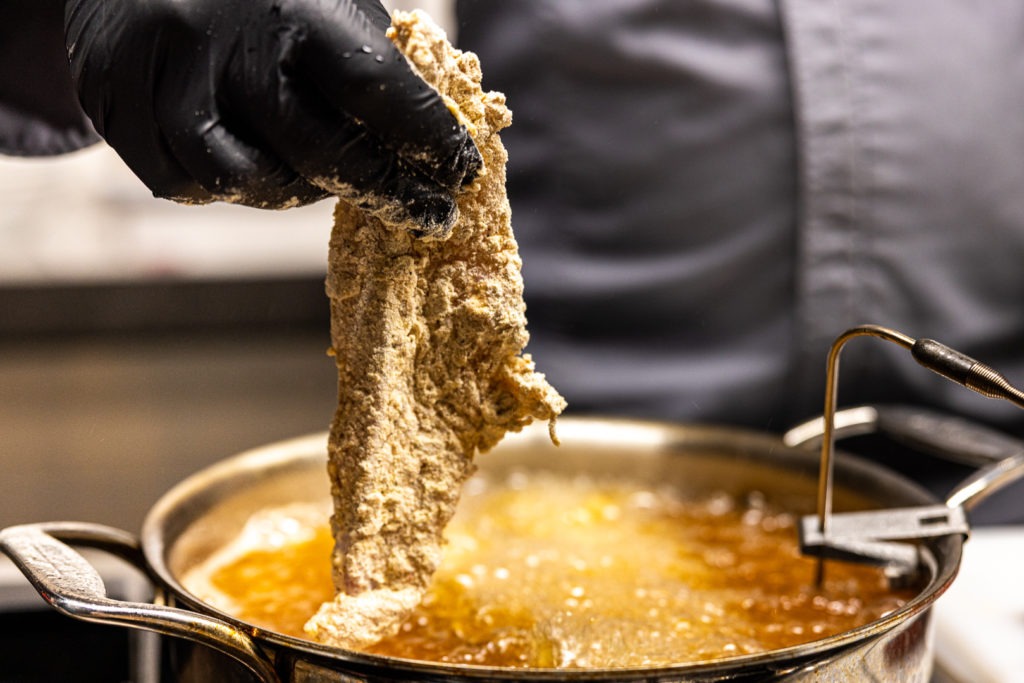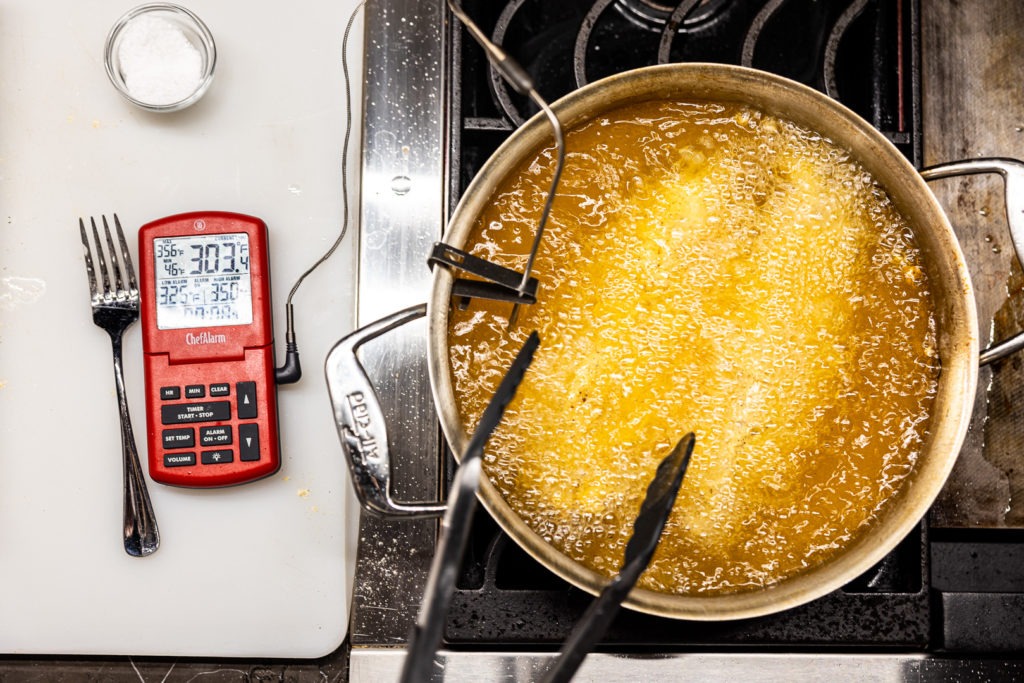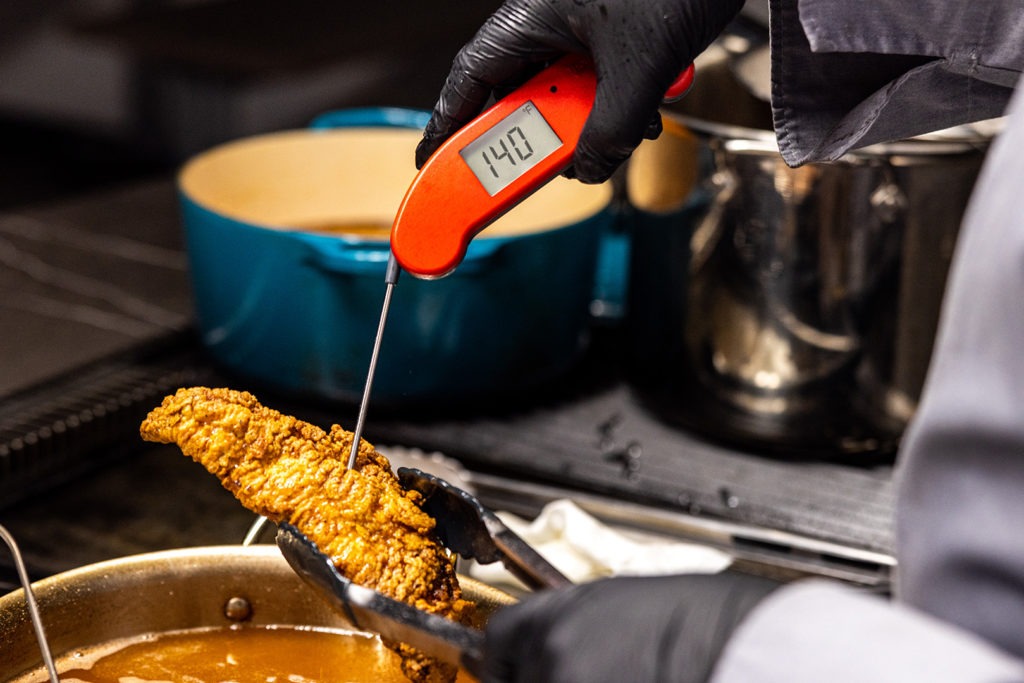If you spend much time in the South—or in South-adjacent areas—of the country, you’re bound to encounter fried catfish. Whether it’s an all-you-can-eat Friday catfish fry, a roadside stand, a food truck at the county fair, or in the kitchen of a good friend, lightly breaded, fried catfish is an indisputable part of Southern cuisine.

You can eat it on a plate alongside slaw and hush puppies (as is often done) or tuck it into a hamburger bun for a phenomenal sandwich. 2 But no matter how you choose to eat it, you want it to be cooked just right. Here, we’ll give you the thermal knowledge you need to make tender, flaky, crispy catfish fillets every time. Get your thermometers out, it’s time for a fish fry!

How to prepare catfish fillets for frying
Southern-fried catfish is prepared differently than is the cod or pollock used for fish-and-chips. Rather than having a thick, battered exterior, catfish only gets a light coating with seasoned cornmeal.
Is that it? Dip it in some cornmeal and fry it? Well no, but close. Most people soak the catfish in a bath of buttermilk before dredging it in a fish-fry mix of cornmeal, flour, and spices. A buttermilk bath can help rid the fish of some of the “muddy” flavor that catfish can have, letting the sweetness of the meat shine through. The tang of the buttermilk is also nice when you have rich fish that has been deep-fried. (I also like to add a few good dashes of hot sauce to my buttermilk bath for even more flavor.)
But the buttermilk, being thick and viscous, also gives the cornmeal something to adhere to. Pull the fish out of the bath and the buttermilk clings to it, then dredge it in the breading and the meal and spices get caught up in the buttermilk. You get enough of a coating, but not too much! The result is a fine, lightly crisp coating that is just right.

What kind of cornmeal should I use for fried catfish?
For fried catfish, you want to use fine cornmeal, not coarse, not even medium. Fine is best. You still get that corny crunch in your mouth, that mealy-in-a-good-way texture, but it’s not so strong that it’s annoying.
Fine cornmeal can be hard to find outside the south, but it can be ordered online. Or if you have a high-power blender, you could try putting your coarse cornmeal in it and processing it down to a much finer meal. It works, but you have to be careful not to overprocess it.
How to fry catfish: critical temperatures
You don’t need a whole pot of oil to fry catfish. It is usually done in a skillet (cast iron works well!) with about a half-inch or so of oil in it.
To get the perfect balance of cooking your fish through without burning the crust (or—almost worse—letting it get oil-logged), run the oil’s heat at 350°F (177°C). A good deep-frying thermometer like ChefAlarm® is essential for this, as the shallow oil heats and cools very quickly when frying. Having high- and low-temp alarms so that you can adjust the heat to keep the oil as close as possible to 350°F (177°C) is a tremendous help.

As for the fish itself, we’re looking for a doneness temp of 140°F (60°C). The flesh cooks quickly and is not very thick, so a fast and accurate instant-read thermometer like Thermapen® ONE is perfect for getting the doneness just right, and the tiny sensor in the tip of the thermometer is great for temping even the thinnest fillets of fish.

What if I don’t like catfish?
If you just can’t stand catfish, by all means, use another fish! This method works equally well for any thin-fillet fish. Use fresh trout, whitefish, crappie, bluegill, or any other panfish. You don’t want super-thick fish (like halibut) because you won’t get a good coating-to-fish ratio, and there would be thermal problems with such a thin coating.
But give the catfish a try. It’s very good, and it’s also good for the country and the earth. In fact, farm-raised, American catfish is one of the most sustainable and tasty fish you can get. It helps American growers and has very little impact on the surrounding ecosystem. Eat as much of it as you like!
I hope you’ll give this recipe a try. It’s fast and easy enough for a weeknight meal, but tasty and celebratory enough for a Sunday dinner with family or friends. Even if you didn’t grow up around the corner from a fish-fry stand or with a trawl line strung across a local creek, you’ll quickly come to appreciate the value of this classic. And with our temperature tips and tools, you’ll know you’ve cooked it right, even before it hits the table. Try it this weekend, and happy cooking!











































